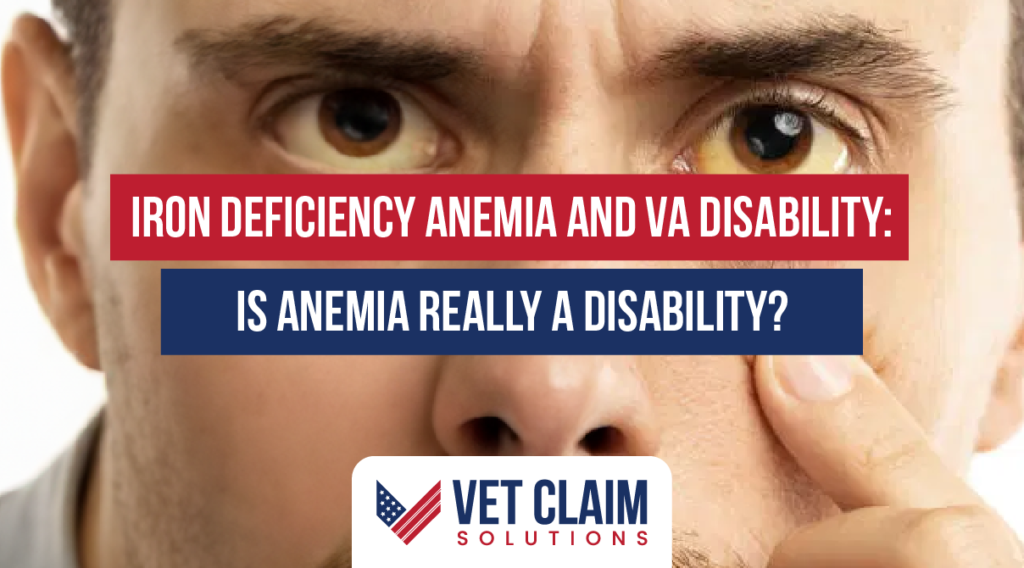Iron Deficiency Anemia and VA Disability: Is Anemia Really a Disability?
Iron deficiency anemia is a common condition that affects millions of people worldwide. It occurs when the body lacks enough iron to produce sufficient red blood cells, leading to symptoms like fatigue, weakness, and shortness of breath. For veterans, anemia can be particularly concerning as it may interfere with their ability to perform daily activities and impact their overall quality of life. However, the question remains: is anemia considered a disability by the Veterans Affairs (VA)? In this article, we will explore the criteria for determining anemia as a disability and discuss the potential benefits available to veterans suffering from this condition.
What is Anemia?

Anemia is a condition characterized by a lack of red blood cells or dysfunctional ones, leading to reduced oxygen flow in the body. It can be caused by blood loss, faulty red blood cell production, or their destruction. Over 400 types of anemia have been identified, with symptoms arising from insufficient oxygen reaching organs and tissues. Diagnosis involves tests for low hemoglobin or hematocrit levels. Treatment options include supplements, medications, and blood transfusions, depending on the type and underlying cause. Prompt diagnosis and management are important to alleviate symptoms and prevent complications.
Types of Anemia
1. Iron-deficiency anemia:
- This is the most common type of anemia
- It occurs when there is insufficient iron in the body to produce adequate amounts of hemoglobin.
- Causes include inadequate dietary intake of iron, blood loss (such as from menstruation or gastrointestinal bleeding), or poor iron absorption

2. Vitamin B12 deficiency anemia:
- This type of anemia results from a deficiency of vitamin B12, which is necessary for red blood cell production.
- Causes include inadequate dietary intake of vitamin B12 (commonly seen in strict vegetarians), malabsorption disorders (such as pernicious anemia), or certain medications that interfere with vitamin B12 absorption.

3. Folic acid deficiency anemia:
- Inadequate intake of folic acid, a B vitamin essential for red blood cell production, leads to this type of anemia.
- Causes include poor dietary intake, malabsorption disorders, certain medications, or increased demand during pregnancy.

4. Hemolytic anemia:
- This form of anemia occurs when red blood cells are destroyed or removed from circulation prematurely.
- It can be inherited or acquired and may result from autoimmune disorders, infections, certain medications, or reactions to blood transfusions.

5. Sickle cell anemia:
- Sickle cell anemia is an inherited form of anemia characterized by abnormal hemoglobin that causes red blood cells to become rigid and deformed.
- The irregular shape of the red blood cells can obstruct blood flow, leading to pain, organ damage, and other complications.

6. Aplastic anemia:
- Aplastic anemia is a rare type of anemia characterized by a decrease in the production of red blood cells, white blood cells, and platelets.
- It may be caused by factors such as autoimmune disorders, infections, exposure to certain chemicals or drugs, or inherited conditions.

Relationship Between Anemia and Active Duty Service
Anemia, a condition characterized by a decrease in the number of red blood cells or the amount of hemoglobin in the blood, can have various causes. While hereditary factors play a significant role in anemia, it can also be a secondary condition resulting from an underlying health issue. Veterans who have served in active duty may experience anemia that is either directly related to their military service or aggravated by it. This recognition by the Department of Veterans Affairs (VA) allows for potential service connection on a secondary basis.

In some cases, a veteran’s service-connected condition may cause or contribute to the development of anemia. For example, conditions like osteomyelitis or hypothyroidism can lead to secondary anemia. Osteomyelitis, an infection of the bone, and hypothyroidism, an underactive thyroid gland, can disrupt the normal production of red blood cells, potentially resulting in anemia. If a veteran can establish a direct link between their service-connected condition and the development or worsening of anemia, they may be eligible for service connection on a secondary basis.
It’s important to note that veterans can still be eligible for service connection for anemia even if the condition existed prior to their military service. If a veteran can demonstrate that their anemia has worsened as a result of their service, they may be able to establish service connection based on aggravation. This means that although the anemia may have preexisted, their military service has significantly worsened the condition.
Service Connection for Anemia
To establish service connection for anemia, there are certain criteria that need to be met. These criteria include a diagnosis of the condition, evidence of an in-service event or aggravation, and a nexus or link between the condition and the veteran’s military service. However, it’s important to note that anemia is also recognized by the VA as a presumptive condition for qualifying veterans.

Anemia is recognized by the VA as a presumptive condition for qualifying veterans.
When a condition is considered presumptive, the VA “presumes” that the condition is service-connected, even if there is no specific nexus established between the condition and military service. This recognition acknowledges that certain conditions, including anemia, may develop or worsen as a result of military service, even without a direct link being established.
Once service connection for anemia is established, the VA will evaluate the severity of the condition using a disability rating system. The disability rating assigned to the veteran will determine the level of compensation and benefits they are entitled to receive. If the anemia is found to be disabling, veterans may be eligible for monthly compensation and access to VA healthcare services to help manage their condition.
VA Disability Rating for Anemia
The specific VA disability rating for anemia depends on the type of anemia and the severity of the symptoms. Each type of anemia has its own diagnostic code and corresponding rating criteria. Here are the disability rating guidelines for different types of anemia:
1. Sickle Cell Anemia:

Veterans in remission but with sustained organ impairment.

Veterans experiencing one to two pain episodes within 12 months.

Veterans with three or more pain episodes in a 12-month period or pain that prevents light manual labor.

Veterans with at least four pain episodes within 12 months, causing significant impairment in major organs, skin, bones, and/or joints.
2. Aplastic Anemia:

Veterans requiring platelet or red blood cell infusions or experiencing infection at least once in 12 months.

Veterans requiring infusions or experiencing infection at least once every 90 days for 12 months, or using continuous therapy with an immunosuppressant agent.

Veterans requiring infusions or experiencing infection at least once every six weeks over 12 months.
3. Iron Deficiency Anemia:

Asymptomatic or requiring treatment only through dietary modification.

Requiring intravenous iron infusions 1 to 3 times per 12-month period, or continuous treatment with oral supplementation.

Requiring intravenous iron infusions 4 or more times per 12-month period.
4. Pernicious Anemia and Vitamin B12 Deficiency Anemia:

Veterans requiring continuous treatment with vitamin B injections, sublingual or high-dose oral tablets, or nasal spray.

Veterans requiring transfusion due to severe anemia or experiencing central nervous system impairment such as peripheral neuropathy, myelopathy, or encephalopathy.
5. Acquired Hemolytic Anemia:

Asymptomatic.

Requiring one course of immunosuppressive therapy per 12-month period.

Requiring 2 to 3 courses of immunosuppressive therapy per 12-month period.

Requiring immunosuppressive medication 4 or more times per 12-month period.

Requiring a bone marrow transplant or continuous intravenous or immunosuppressive therapy.
6. Folic Acid Deficiency Anemia:

Asymptomatic or easily controlled by diet.

Requiring continuous high-dose folic acid supplementation.
FAQs
1. What is iron deficiency anemia?
A: Iron deficiency anemia is a type of anemia caused by a lack of iron in the body. It happens when the body does not have enough red blood cells to carry oxygen to the tissues.
2. Can iron deficiency anemia be considered a disability?
A: Iron deficiency anemia can be considered a disability if it affects your ability to work and perform daily activities. However, in order to receive disability benefits, you need to file a disability claim with the VA.
3. How do I file a disability claim for iron deficiency anemia?
A: To file a disability claim for iron deficiency anemia, you need to submit an application to the VA. This application should include medical evidence that proves your condition and shows how it affects your ability to work and perform daily activities.
4. What are the criteria for receiving VA disability benefits for iron deficiency anemia?
A: In order to be eligible for VA disability benefits for iron deficiency anemia, you need to meet the VA’s requirements for a service-connected disability. This means that your anemia must be related to your military service or a condition that was caused or aggravated by your military service.
5. How does the VA evaluate iron deficiency anemia for disability ratings and compensation?
A: The VA evaluates iron deficiency anemia based on the severity of your condition and how it affects your ability to work and perform daily activities. The VA uses the schedule of ratings to determine your disability rating and the amount of compensation you may be eligible to receive.
6. Are veterans with iron deficiency anemia eligible for disability benefits?
A: Veterans with iron deficiency anemia may be eligible for disability benefits if their condition is determined to be service-connected and if it affects their ability to work and perform daily activities. It is important to file a disability claim with the VA to determine eligibility.
7. What is the process for receiving VA disability benefits for iron deficiency anemia?
A: The process for receiving VA disability benefits for iron deficiency anemia involves filing a disability claim, submitting medical evidence, attending any required examinations, and waiting for the VA to make a decision on your claim. It is important to gather all necessary documentation and follow the VA’s guidelines for filing a claim.
8. Can iron deficiency anemia be considered a service-connected disability?
A: Iron deficiency anemia can be considered a service-connected disability if it is determined to be related to your military service or a condition that was caused or aggravated by your military service. It is important to provide medical evidence and documentation of the connection between your anemia and your military service.
Need Help About Your Anemia Claim?
If you or a loved one is struggling with anemia and need help with your claim, Vet Claim Solutions is here to assist you. Our team of experienced vet coaches understands the complexities of the claims process and can guide you through every step. We are committed to advocating for your rights and ensuring you receive the compensation you deserve. Contact us today for a consultation.



This Post Has One Comment
Nice post. I learn something totally new and challenging
on sites I stumbleupon on a daily basis. It will always
be useful to read content from other writers and practice a little something
from other web sites.